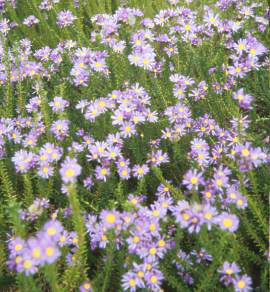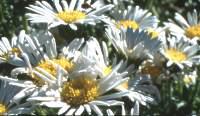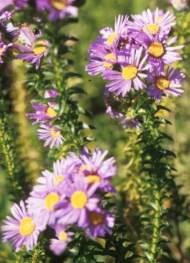Felicia echinata
Felicia echinata (Thunb.) Nees
Family: Asteraceae
Common names: dune daisy, prickly felicia (Eng.), bloublommetjie (Afr.)
Introduction
Felicia echinata is easy to recognize by its glossy leaves that are edged with small white teeth and curved to form a sharp tip. This prickly protection is most probably to discourage animals and insects from taking a bite.
Description
Description
Felicia echinata is an evergreen, much branched perennial that grows to about 60 cm high. The branches are almost entirely covered with the shiny, dark green leaves. The stiff little leaves are oval to triangular in shape, pointing downwards away from the stem - almost overlapping each other. The branches bend and turn, relaxing on the ground and then turning up to the sun, each with 2 - 3 large daisies at their tips.

The flowers are usually mauve with a bright yellow centre, but white flowers are also occasionally found in the wild. Both forms flower profusely for a few months from autumn to spring. After flowering the flowers turn into fluffy seed heads. The seeds are light brown, flat and oval shaped with a tuft of long hairs attached to the tip, which allows them to be carried away on the breeze.

Conservation Status
Status
According to the Red List of South African Plants, the conservation status of Felicia echinata is Least Concern (LC).

Distribution and habitat
Distribution description
In nature this felicia is frequently seen next to roads and on sandy dunes along the coast of the eastern Cape from Mossel Bay to Port Alfred, where it flowers from around April until October (autumn to early summer). Here they grow with other herbaceous plants like the Cape forget-me-not (Anchusa capensis), lobelias and gazanias.
Derivation of name and historical aspects
History
Its prickles give this plant its name: echinata, which means 'covered with prickles' in Latin.
There are more than 85 species of Felicia found from southern and tropical Africa to Arabia.
Ecology
Ecology
Its prickles probably help protect this plant from herbivores.
Uses
Use
This felicia is well suited to the waterwise garden, giving flower colour for many months. The bright green, spiky leaves also add interesting foliage texture throughout the year.

Growing Felicia echinata
Grow
Felicia echinata will grow in almost any well-drained soil in a sunny position. This plant can be considered tender to frost, and in very cold areas it needs to be planted in a warm protected position.
For the best display, plants should be grouped quite close together. Both the mauve and white forms are commercially available and often sold in 6-packs, which makes mass planting much easier. Felicia echinata works best as a filler between longer lived plants like restios or in short lived herbaceous displays. It also looks good planted in rockeries and terraforce walls where the plants hang down and soften the hard edges. They are excellent when planted with large aloes such as Aloe arborescens and Aloe succotrina, pig's ears (Cotyledon orbiculata) and vygies, where they serve to soften the succulents. The foliage also contrasts well with the long linear leaves of bulbous plants such as Chasmanthe, Aristea and Dietes or shrubs such as the kruidjie-roer-my-nie (Melianthus major) with its large grey leaves. In mass plantings it makes a good groundcover, but starts to look brown and leggy after about 4 years. Light pruning after flowering will help to keep the plants more compact and vigorous.
Felicia echinata can be propagated by cuttings or seed. New plants are easy to produce from cuttings, taken at almost any time of the year, but best in spring or autumn. Rooting is rapid and the new plants will be ready for planting within a few months. Occasionally branches root where they touch the ground. Seed can be sown in autumn or spring. The seeds germinate within about 3 weeks and produce seedlings that will flower the next season.
References
- Goldblatt, P. & Manning, J., 2000, Cape Plants, A Conspectus of the Cape Flora of South Africa, NBI, Pretoria & Missouri Botanical Garden Press, Missouri
- Eliovson, Sima, 1973, South African Wild Flowers for the Garden, Macmillan, Johannesburg
- Gledhill,Eily, 1981, Eastern Cape Veld Flowers, Dept. Nature Conservation, Cape Town.
Credits
Liesl van der Walt
Kirstenbosch
August 2001
Plant Attributes:
Plant Type: Shrub
SA Distribution: Eastern Cape, Western Cape
Soil type: Sandy, Clay, Loam
Flowering season: Spring, Autumn, Winter
PH: Acid, Alkaline, Neutral
Flower colour: White, Yellow, Mauve/Lilac
Aspect: Full Sun, Afternoon Sun (Semi Shade)
Gardening skill: Easy
Special Features:
Horticultural zones











Rate this article
Article well written and informative
Rate this plant
Is this an interesting plant?
Login to add your Comment
Back to topNot registered yet? Click here to register.